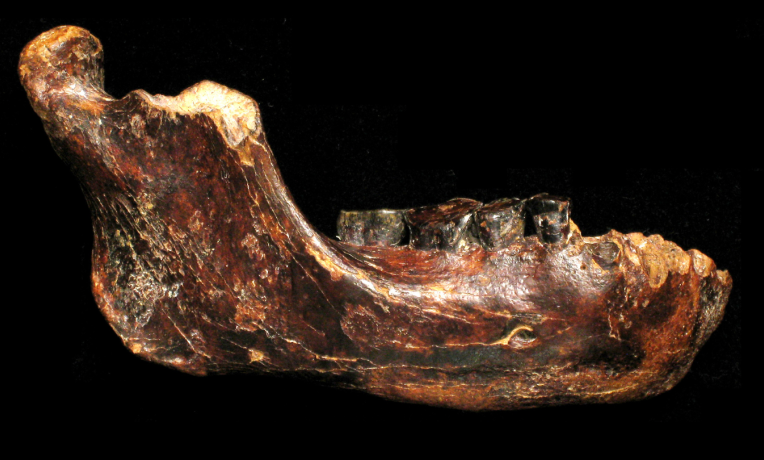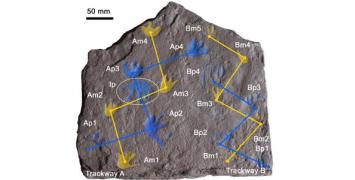Denisovans, an extinct human species, once lived in East Asia, fossil shows

An international team of researchers has identified the prehistoric human mandible known as Penghu 1, found off the coast of Taiwan, as belonging to a male Denisovan. Denisovans are an extinct group of archaic humans previously known mainly from remains discovered in Siberia and Tibet. Using palaeoproteomic techniques, the team confirmed the fossil’s identity, extending the known Denisovan range into East Asia and offering new insights into their physical traits and environmental adaptability.
The findings are published today (April 10, 2025) in Science
The Penghu 1 mandible was recovered from the seabed in the Penghu Channel, an area that was part of the Asian mainland during Pleistocene-era low sea levels. Its age is estimated to be between 10 000 - 70 000 or 130 000 - 190 000 years old. While morphologically distinct and archaic, its exact placement in the evolutionary tree remained uncertain until now, because previous attempts to extract DNA had failed.
‘Identifying Penghu 1 as Denisovan confirms inferences from modern human genetics that these ancient hominins were widespread across eastern Asia and adapted to diverse environments, from the cold north to warmer, humid regions like Pleistocene Taiwan,’ says Takumi Tsutaya, Assistant Professor at the Research Center for Integrative Evolutionary Science, Graduate University for Advanced Studies, co-leading author on the paper, and leader of the Japan Science and Technology Agency FOREST project. ‘This discovery is crucial because it provides direct molecular evidence of Denisovans far from the initially discovered sites in Siberia and Tibet,' adds Rikai Sawafuji, Lecturer at the Faculty of Social and Cultural Studies, Kyushu University, and co-leading author on the paper.
By analysing 4 241 amino acid residues from 51 proteins, the scientists identified two protein variants specific to Denisovans in the Penghu 1 sample. Phylogenetic analysis further confirmed that the mandible clusters with Denisovans, distinctly separate from Neanderthals and modern humans. 'The proteome recovery achieved for the Penghu 1 mandible is testimony to years of methodological development on the sampling, extraction, and analysis of ancient protein fragments. With the newly available methods and molecular and morphological insights gained, palaeoproteomics is ready to study further possible Denisovan fossil material,' says Frido Welker, Associate Professor at the Globe Institute, University of Copenhagen, co-senior author on the paper, and leader of the European Research Council Starting Grant “PROSPER” project.
Furthermore, the recovery of the variant of the amelogenin protein that is coded on the Y chromosome (AMELY), by non-destructively etching the tooth enamel with a drop of acid, confirmed the specimen belonged to a male individual.
´Thanks to the surprisingly high protein recovery, we confidently assigned the specimen to a male individual in less than 24 hours from the moment it arrived in the lab. You don’t see that every day!’ says Enrico Cappellini, Professor at the Globe Institute, University of Copenhagen, co-senior author on the paper, and leader of the European Research Council Advanced Grant “BACKWARD” and Proof of Concept Grant “SSPIN” projects, as well as coordinator of the Marie S. Curie European Training Network “PUSHH”.
The identification of Penghu 1 provides direct fossil evidence supporting the widespread distribution of Denisovans across diverse environments in eastern Asia, from the cold north to the warmer, humid conditions of subtropical Taiwan during the Pleistocene. The study also highlights distinct physical traits shared by Denisovan fossils like Penghu 1 and the Xiahe mandible from Tibet, including robust jawbones and large teeth, which contrast markedly with their sister group, the Neanderthals. These findings suggest Denisovans developed unique physical characteristics after splitting from the Neanderthal lineage over 400 000 years ago.
‘When we first described the Penghu mandible ten years ago, the combination of a robust jaw and large teeth made us think that it belonged to a very primitive lineage of Homo which has nothing to do with Neanderthals. So these results from proteomics were surprising. The evolutionary history of our genus was more complex and diverse than we have thought,’ says Yousuke Kaifu, Professor at The University Museum, The University of Tokyo, and co-leading author on the paper.
Palaeoproteomics continues to deliver groundbreaking results, through an extensive collaboration between different research fields such as, among others: paleoanthropology, biochemistry, proteomics and population genomics.
‘The Penghu Channel on the seabed of the Taiwan Strait preserves many important fossils, providing crucial evidence for the evolution and adaptation of Quaternary mammals in the Eurasian continent. Among them, "Penghu 1" stands out as the most significant discovery!’ says Chun-Hsiang Chang, Curator of Paleontology at Center of Science, National Museum of Natural Science, Taiwan, and co-corresponding author on the paper.
About the Research
The study utilized palaeoproteomics, the analysis of ancient proteins, to identify the Penghu 1 fossil hominin mandible. This technique is crucial for studying fossils from regions or time periods where DNA preservation is poor. The findings contribute significantly to understanding the diversity, distribution, and evolution of archaic humans in Asia.
About the Globe Institute
The Globe Institute at the University of Copenhagen is a leading research institution dedicated to the study of evolutionary science, ancient DNA, and palaeoproteomics. The institute's interdisciplinary approach combines cutting-edge technology with traditional archaeological methods to uncover the secrets of our past.
Publication
The full research findings are detailed in the paper titled "A male Denisovan mandible from Pleistocene Taiwan," published in the journal Science.
Main fundings
Japan Society for the Promotion of Science (JSPS) Grants-in-Aid for Scientific Research 19H05350, 20H05821, 20H05822, 20KK0166, 202170033, 23K17404 (T.T., H.O., Y.K., and R.S.)
Japan Science and Technology Agency (JST) Exploratory Research for Advanced Technology JPMJFR233D (T.T.)
Taiwan Ministry of Science and Technology 112-2621-B- 002-005 111- 2621-B-002-006 108-2621-B-002-006-MY3 (C.-H.T.)
European Research Council (ERC) under the European Union’s Horizon 2020 research and innovation program, grant agreement 948365 (PROSPER) (F.W.)
ERC under the European Union’s Horizon 2020 research and innovation program, grant agreement 101021361 (BACKWARD) (E.C.)
ERC under the European Union’s Horizon 2020 research and innovation program, grant agreement 101138962 (SSPIN) (E.C.)
Marie Sklodowska-Curie training network, under the European Union’s Horizon 2020 research and innovation program 861389 (PUSHH) (E.C.)




